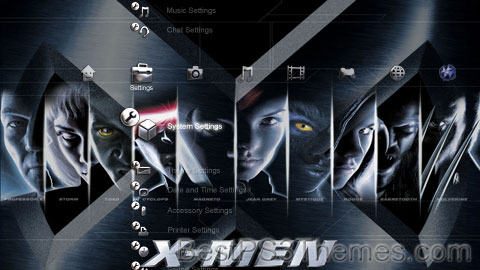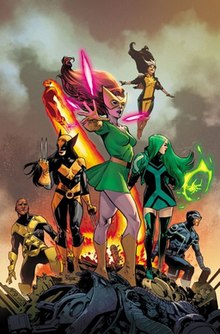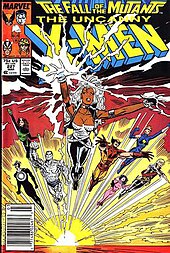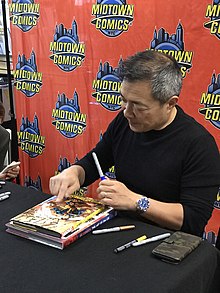X-Men theme by PDSangster
Download: X-Men.p3t

(1 background)
| X-Men | |
|---|---|
 Variant cover of X-Men (vol. 6) #2 (October 2021) depicting the first elected Krakoan X-Men team (clockwise from left): Synch, X-23, Sunfire, Marvel Girl, Rogue, Polaris, and Cyclops. Art by Mahmud Asrar. | |
| Publication information | |
| Publisher | Marvel Comics |
| First appearance | The X-Men #1 (September 1963) |
| Created by | Stan Lee Jack Kirby |
| In-story information | |
| Base(s) | Current: The Morlocks' Alley New York Sewer System New York City Former: Xavier's School for Gifted Youngsters Westchester County, New York The Treehouse (Krakoan base) New York City |
| Member(s) | Current: Cannonball Colossus Cyclops Dazzler Feint Firestar Forge Frenzy Jubilee Gambit Juggernaut Magik Ms. Marvel Nightcrawler Polaris Prodigy Rasputin IV Rogue Shadowkat Synch Talon White Queen Wolverine Woofer Former: See List of X-Men members |
The X-Men are a superhero team appearing in American comic books published by Marvel Comics. Created by writer/editor Stan Lee and artist/co-plotter Jack Kirby, the team first appeared in The X-Men #1 (September 1963).[1] Although initially cancelled in 1970 due to low sales, following its 1975 revival and subsequent direction under writer Chris Claremont, it became one of Marvel's most recognizable and successful franchises.[2] They have appeared in numerous books, television shows, 20th Century Fox's X-Men films, and video games. The X-Men title may refer to the superhero team itself, the eponymous comic series, or the broader franchise including various solo titles and team books such as the New Mutants, Excalibur, and X-Force.
In the Marvel Universe, mutants are humans who are born with a genetic trait called the X-gene which grants them natural superhuman abilities, generally manifesting during puberty. Due to their differences from the majority of humanity, mutants are subject to prejudice and discrimination; many X-Men stories feature social commentary on bigotry, justice, and other political themes. The X-Men have fought against a variety of enemies, including villainous mutants, human bigots, supervillains, mystical threats, extraterrestrials, and malevolent artificial intelligence. In most iterations of the team, they are led by their founder Charles "Professor X" Xavier, a powerful telepath who runs a school for mutant children out of his mansion in Westchester, New York, which secretly is also the headquarters of the X-Men. Their stories have frequently involved Magneto, a powerful mutant with control over magnetic fields, who is depicted as an old friend of and foil to Xavier, variously acting as an adversary or as an ally.
Background and creation[edit]
In 1963, with the success of Spider-Man, the Hulk, Thor, Iron Man, and the Fantastic Four, co-creator Stan Lee wanted to create another group of superheroes but did not want to have to explain how they got their powers. In 2004, Lee recalled, "I couldn't have everybody bitten by a radioactive spider or exposed to a gamma ray explosion. And I took the cowardly way out. I said to myself, 'Why don't I just say they're mutants? They are born that way.'"[3]
In a 1987 interview, Kirby said:
The X-Men, I did the natural thing there. What would you do with mutants who were just plain boys and girls and certainly not dangerous? You school them. You develop their skills. So I gave them a teacher, Professor X. Of course, it was the natural thing to do, instead of disorienting or alienating people who were different from us, I made the X-Men part of the human race, which they were. Possibly, radiation, if it is beneficial, may create mutants that'll save us instead of doing us harm. I felt that if we train the mutants our way, they'll help us – and not only help us, but achieve a measure of growth in their own sense. And so, we could all live together.[4]
Lee devised the series title after Marvel publisher Martin Goodman turned down the initial name, "The Mutants," stating that readers would not know what a "mutant" was.[5]
Within the Marvel Universe, the X-Men are widely regarded to have been named after Professor Xavier himself. The original explanation for the name, as provided by Xavier in The X-Men #1 (1963), is that mutants "possess an extra power ... one which ordinary humans do not!! That is why I call my students ... X-Men, for EX-tra power!"[6]
DC Comics's Doom Patrol, which debuted several months before X-Men, was suspected by its creator Arnold Drake and its fans of having had the basic concept copied to a great degree – including a wheel-chair using leader – by Marvel Comics to create the X-Men. Other fans also speculate that Doom Patrol share similarities with another Marvel superhero team that preceded them, the Fantastic Four.
Publication history[edit]
Original run[edit]

Early X-Men issues introduced the original team composed of Cyclops, Marvel Girl, Beast, Angel, and Iceman, along with their archenemy Magneto and his Brotherhood of Evil Mutants featuring Mastermind, Quicksilver, Scarlet Witch, and Toad. The comic focused on a common human theme of good versus evil and later included storylines and themes about prejudice and racism, all of which have persisted throughout the series in one form or another. The evil side in the fight was shown in human form and under some sympathetic beginnings via Magneto, a character who was later revealed to have survived Nazi concentration camps only to pursue a hatred for normal humanity. His key followers, Quicksilver and the Scarlet Witch, were Romani. Only one new member of the X-Men was added, Mimic/Calvin Rankin,[7] but soon left due to his temporary loss of power.[8]
The title lagged in sales behind Marvel's other comic franchises. In 1969, writer Roy Thomas and illustrator Neal Adams rejuvenated the comic book and gave regular roles to two recently introduced characters: Alex "Havok" Summers (Cyclops' brother, who had been introduced by Roy Thomas before Adams began work on the comic) and Lorna Dane, later called Polaris (created by Arnold Drake and Jim Steranko). However, these later X-Men issues failed to attract sales and Marvel stopped producing new stories with issue #66 (March 1970), later reprinting a number of the older comics as issues #67–93.[9]
Claremont Era[edit]
This section needs additional citations for verification. (June 2011) |

In Giant-Size X-Men #1 (1975), writer Len Wein and artist Dave Cockrum introduced a new team that starred in a revival of The X-Men, beginning with issue #94. This new team replaced the previous members with the exception of Cyclops, who remained. This team differed greatly from the original. Unlike in the early issues of the original series, the new team was not made up of teenagers and they also had a more diverse background. Marvel's corporate owners, Cadence Industries, had suggested the new team should be international, feeling it needed characters with "foreign appeal".[10] So each character was from a different country with varying cultural and philosophical beliefs, and all were already well-versed in using their mutant powers, several being experienced in combat.
The "all-new, all-different X-Men"[11] were led by Cyclops, from the original team, and consisted of the newly created Colossus (from the Soviet Union/Russia), Nightcrawler (from West Germany/Germany), Storm (from Kenya), and Thunderbird (a Native American of Apache descent), and three previously introduced characters: Banshee (from Ireland), Sunfire (from Japan), and Wolverine (from Canada). Wolverine eventually became the breakout character on the team and, in terms of comic sales and appearances, the most popular X-Men character, even getting his own solo title. However, this team would not remain whole for long; Sunfire, who never really accepted the other members, quit shortly after their first mission, and Thunderbird died on the next. Filling in the vacancy, a revamped Jean Grey soon rejoined the X-Men under her new persona of "Phoenix". Angel, Beast, Iceman, Havok, and Polaris also made significant guest appearances.
The revived series was illustrated by Cockrum, and later by John Byrne, and written by Chris Claremont. Claremont became the series' longest-running contributor.[12] The run met with critical acclaim and produced such landmark storylines as the death of Thunderbird, the emergence of Phoenix, the saga of the Starjammers and the M'Kraan Crystal, the introduction of Alpha Flight and the Proteus saga.[13] Other characters introduced during this time include Amanda Sefton, Mystique, and Moira MacTaggert, with her genetic research facility on Muir Island.
The 1980s began with the comic's best-known story arc, the Dark Phoenix Saga, which saw Phoenix manipulated by the illusionist Mastermind and becoming corrupted with an overwhelming lust for power and destruction as the evil Dark Phoenix. Other important storylines included Days of Future Past, the saga of Deathbird and the Brood, the discovery of the Morlocks, the invasion of the Dire Wraiths and The Trial of Magneto!, as well as X-Men: God Loves, Man Kills, the partial inspiration for 20th Century Fox's movie X2: X-Men United, which was released on May 2, 2003.[14]

By the early 1980s, X-Men was Marvel's top-selling comic title. Its sales were such that distributors and retailers began using an "X-Men index", rating each comic book publication by how many orders it garnered compared to that month's issue of X-Men.[15] The growing popularity of Uncanny X-Men and the rise of comic book specialty stores led to the introduction of a number of ongoing spin-off series nicknamed "X-Books." The first of these was The New Mutants, soon followed by Alpha Flight, X-Factor, Excalibur, and a solo Wolverine title. When Claremont conceived a story arc, the Mutant Massacre, which was too long to run in the monthly X-Men, editor Louise Simonson decided to have it overlap into several X-Books. The story was a major financial success,[16] and when the later Fall of the Mutants was similarly successful, the marketing department declared that the X-Men lineup would hold such crossovers annually.[17]
Throughout the decade, Uncanny X-Men was written solely by Chris Claremont, and illustrated for long runs by John Byrne, Dave Cockrum, Paul Smith, John Romita Jr., and Marc Silvestri. Additions to the X-Men during this time were Kitty Pryde/Shadowcat, Rogue, Jean Grey/Phoenix, Psylocke, Dazzler, Longshot, Jubilee, Forge and Gambit. In a controversial move, Professor X relocated to outer space to be with Lilandra Neramani, Majestrix of the Shi'ar Empire, in 1986. Magneto then joined the X-Men in Xavier's place and became the director of the New Mutants. This period also included the emergence of the Hellfire Club, the arrival of the mysterious Madelyne Pryor, and the villains Apocalypse, Mister Sinister, Mojo, and Sabretooth.
- X-Men
- Uncanny X-Men, vol. 1 (flagship) – a team of young mutants with superhuman abilities led and taught by Professor X (1963–1970); the team expanded when Xavier recruited mutants from around the world (1975–1985); a reformed Magneto became the headmaster after Xavier had left Earth (1985–1988); the team later relocated to the Australian Outback after the events of The Fall of the Mutants (1988–1989); after the X-Men is disassembled, the team reformed to fight the mutant-rights abuse of Genosha (1991).
- X-Factor, vol. 1 – the Original Five set up a business advertised as mutant-hunters for hire, and secretly trained the captured mutants to control their powers and reintegrate them into society (1986–1991).
- Excalibur, vol. 1 – Nightcrawler, Shadowcat and Rachel Grey teamed up with Captain Britain and Meggan to form a group of mutants based in Europe after the apparent death of the X-Men during The Fall of the Mutants (1988–1992).
- X-Men in Training
- New Mutants, vol. 1 – a group of teenaged students of the School for Gifted Youngsters gathered by Professor X
- Other Teams
- Alpha Flight, vol. 1 – Canada's premiere team of super-heroes organized under the auspices of the Canadian government's Department H.
Blue and Gold[edit]

In 1991, Marvel revised the entire lineup of X-Men comic book titles, centered on the launch of a second X-Men series, simply titled X-Men. With the return of Xavier and the original X-Men to the team, the roster was split into two strike forces: Cyclops's "Blue Team" (chronicled in X-Men) and Storm's "Gold Team" (in The Uncanny X-Men).
The first issues of the second X-Men series were written by Claremont and drawn and co-plotted by Jim Lee. Retailers pre-ordered over 8.1 million copies of issue #1, generating and selling nearly $7 million (though retailers probably sold closer to 3 million copies),[18] making it, according to Guinness Book of World Records, the best-selling comic book of all-time. Guinness presented honors to Claremont at the 2010 San Diego Comic-Con.[19][20][21]
Another new X-book released at the time was X-Force, featuring the characters from The New Mutants, led by Cable; it was written by Rob Liefeld and Fabian Nicieza. Internal friction soon split the X-books' creative teams. In a controversial move, X-Men editor Bob Harras sided with Lee (and Uncanny X-Men artist Whilce Portacio) over Claremont in a dispute over plotting. Claremont left after only three issues of X-Men, ending his 16-year run as X-Men writer.[22] Marvel replaced Claremont briefly with John Byrne, who scripted both books for a few issues. Byrne was then replaced by Nicieza and Scott Lobdell, who would take over the majority of writing duties for the X-Men until Lee's own departure months later when he and several other popular artists (including former X-title artists Liefeld, Portacio, and Marc Silvestri) would leave Marvel to form Image Comics. Jim Lee's X-Men designs would be the basis for much of the X-Men animated series and action figure line as well as several Capcom video games.
The 1990s saw an even greater number of X-books with numerous ongoing series and miniseries running concurrently. X-book crossovers continued to run annually, with "The X-Tinction Agenda" in 1990, "The Muir Island Saga" in 1991, "X-Cutioner's Song" in 1992, "Fatal Attractions" in 1993, "Phalanx Covenant" in 1994, "Legion Quest"/"Age of Apocalypse" in 1995, "Onslaught" in 1996, "Operation: Zero Tolerance" in 1997, "Hunt for Xavier" in 1998, "The Magneto War" in 1999, "Apocalypse: The Twelve" / "Ages of Apocalypse" in 2000 and "Eve of Destruction" in 2001. Though the frequent crossovers were criticized by fans as well as editorial and creative staff for being artificially regular, disruptive to the direction of the individual series, and having far less lasting impact than promised, they continued to be financially successful.[17]
There were many additions to the X-Men in the 1990s, including Gambit, Cable, and Bishop. Gambit became one of the most popular X-Men, rivaling even Wolverine in size of fanbase after his debut in Uncanny X-Men #266 (Aug. 1990). Many of the later additions to the team came and went, such as Joseph, Maggott, Marrow, Cecilia Reyes, and a new Thunderbird. Xavier's New Mutants grew up and became X-Force, and the next generation of students began with Generation X, featuring Jubilee and other teenage mutants led and schooled by Banshee and ex-villainess Emma Frost at her Massachusetts Academy. In 1998, Excalibur and X-Factor ended and the latter was replaced with Mutant X, starring Havok stranded in a parallel universe. Marvel launched a number of solo series, including Deadpool, Cable, Bishop, X-Man, Gambit, Maverick, Rogue, Storm, Magneto, Beast, Domino, Warlock, Magik, Iceman and Sabretooth, but few of the series would survive the decade.
- X-Men
- Uncanny X-Men, vol. 1 (flagship) – initially featured the Gold Team strike force led by Storm (1991–1995); later featured a team of X-Men recruited by Gladiator to defend the Shi'ar Empire against the Phalanx (1997); the Gold and Blue strike force merged to face new threats including Onslaught, Dark Beast, Shadow King and Magneto (1997–2000); later featured a squad led by Gambit during the Revolution revamp (2000–2001). The title is replaced by Astonishing X-Men during the Age of Apocalypse event.
- X-Men, vol. 2 – initially featured the Blue Team strike force led by Cyclops (1991–1995); later featured a new core group consisting of Cannonball, Cyclops, Jean Grey, Storm and Wolverine took on Sebastian Shaw and Bastion during the events of Operation: Zero Tolerance (1997); members of the Excalibur team joined the combined Gold and Blue strike force (1997–2000); later featured a squad led by Rogue during the Revolution revamp (2000–2001). The title is replaced by Amazing X-Men during the Age of Apocalypse event.
- X-Force, vol. 1 – Cable re-organized the New Mutants into the para-military mutant strike team (1991–1995); the team move in with the X-Men at the X-Mansion and effectively become the X-Men's junior team (1995–1997); the team later move to San Francisco to set up a new headquarter (1997–2001); the team becomes a covert ops superhero team under the leadership of Pete Wisdom during the Revolution revamp (2001). The title is replaced by Gambit & the X-Ternals during the Age of Apocalypse event.
- X-Men in Training
- Generation X, vol. 1 – students at the Massachusetts Academy mentored by Banshee and the former villain White Queen (1994–2001). The title is replaced by Generation Next during the Age of Apocalypse event.
- Other Teams
- X-Factor, vol. 1 – the new team worked for the Pentagon replacing Freedom Force as the government-sponsored team (1991–1997); Forge later leads the mutant team as an underground government strike force (1997–1998). The title is replaced by Factor X during the Age of Apocalypse event.
- Excalibur, vol. 1 – the British team expanded and stays with Moira, making Muir Island their new base (1992–1998). The title is replaced by X-Calibre during the Age of Apocalypse event.
- Alpha Flight, vol. 2 – A new team formed by the reinstated Department H which is involved in clandestine and criminal activities.
Morrison era[edit]
In 2000, Claremont returned to Marvel and was put back on the primary X-Men titles during the Revolution revamp. He was later removed from the titles in 2001 and created his spin-off series, X-Treme X-Men. X-Men had its title changed to New X-Men and writer Grant Morrison took over. The book is often referred to as the Morrison-era, due to the drastic changes they made, beginning with "E Is For Extinction", where a new villain, Cassandra Nova, destroys Genosha, killing sixteen million mutants. Morrison also brought reformed ex-villain Emma Frost into the primary X-Men team, and opened the doors of the school by having Xavier "out" himself to the public about being a mutant. The bright spandex costumes that had become iconic over the previous decades were replaced by black leather street clothes reminiscent of the uniforms of the X-Men films. Morrison also introduced Xorn, who would figure prominently in the climax of his run. Ultimate X-Men set in Marvel's revised imprint was also launched, while Chuck Austen began his controversial run on Uncanny X-Men.
Several short-lived spin-offs and miniseries started featuring several X-Men in solo series, such as Emma Frost, Mystique, Cyclops, Iceman, Blink, Chamber, Mekanix (featuring Kitty Pryde), and Nightcrawler. Many of the second-tier X-books were relaunched with new titles: Cable became Soldier X and Deadpool became Agent X.
A new series titled X-Statix spawns from and replaces X-Force; it is a series that explores the crossroads between heroism and being a celebrity, and how being a mutant is only acceptable as a medium of disposable entertainment. It was known best for being a series that killed most of the introduced cast and having one of the highest team turnover rates for a superhero comic. The most prominent member to come out of X-Statix was Doop who is a green glob reminiscent of Slimer from Ghost Busters.
Another series, Exiles, started at the same time and concluded in December 2007 which led to New Exiles in January 2008 written by Claremont.
Notable additions to the X-Men have been Emma Frost, Danielle Moonstar, Husk and Northstar while former villain Juggernaut became member of the X-Men. Notable story arcs of this era are "E Is For Extinction" (2001), "Planet X" and "Here Comes Tomorrow".
